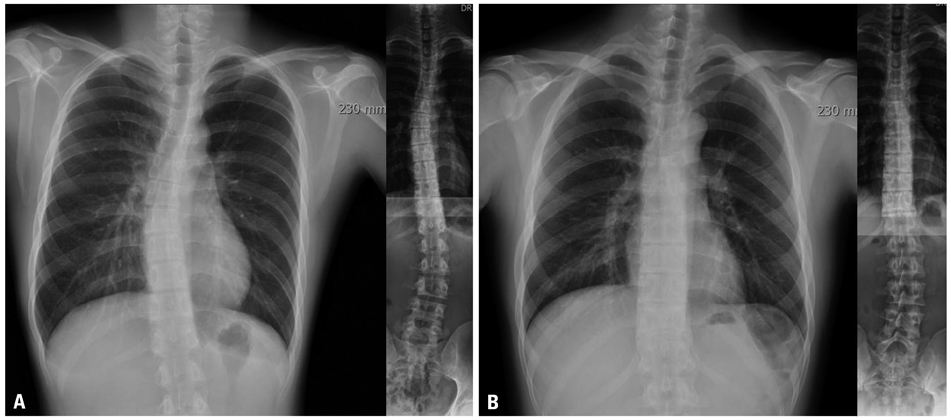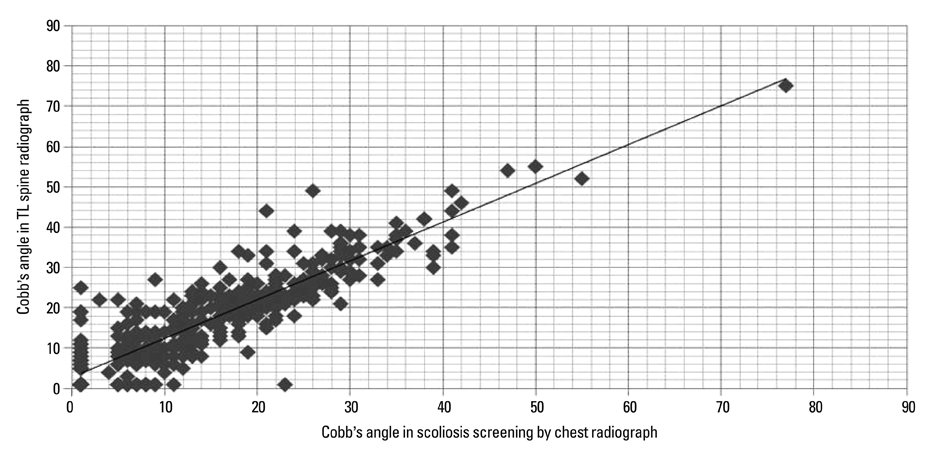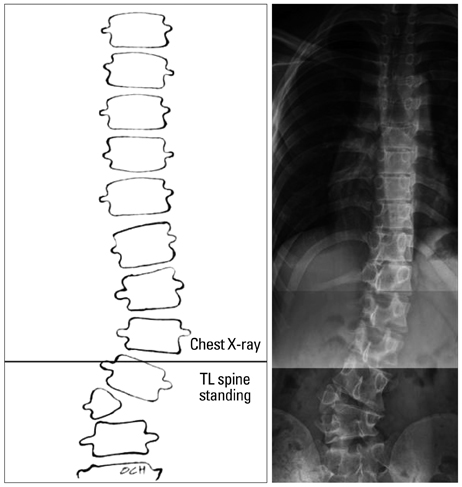Yonsei Med J.
2012 Nov;53(6):1183-1189. 10.3349/ymj.2012.53.6.1183.
Usefulness of Chest Radiographs for Scoliosis Screening: A Comparison with Thoraco-Lumbar Standing Radiographs
- Affiliations
-
- 1Seoul Regional Military Manpower Administration, Seoul, Korea.
- 2Department of Neurosurgery, College of Medicine, Inha University, Incheon, Korea. nsyoon@gmail.com
- KMID: 1414262
- DOI: http://doi.org/10.3349/ymj.2012.53.6.1183
Abstract
- PURPOSE
The purposes of this study were to evaluate the usefulness and limitations of chest radiographs in scoliosis screening and to compare these results with those of thoraco-lumbar standing radiographs (TLSR).
MATERIALS AND METHODS
During Korean conscription, 419 males were retrospectively examined using both chest radiographs and TLSR to confirm the scoliosis and Cobb angle at the Regional Military Manpower. We compared the types of spinal curves and Cobb angles as measured from different radiographs.
RESULTS
In the pattern of spinal curves, the overall matching rate of chest radiographs using TLSR was about 58.2% (244 of 419 cases). Cobb angle differences between chest radiographs and TLSR with meaningful difference was observed in 156 cases (37.2%); a relatively high proportion (9.5%) of Cobb angle differences more than 10 degrees was also observed. The matching rate of both spinal curve types and Cobb angle accuracy between chest radiographs and TLSR was 27.9% (117 among 419 cases). Chest radiographs for scoliosis screening were observed with 93.94% of sensitivity and 61.67% of specificity in thoracic curves; however, less than 40% of sensitivity (38.27%, 20.00%, and 25.80%) and more than 95% of specificity (97.34%, 99.69%, and 98.45%) were observed in thoraco-lumbar, lumbar, and double major curves, respectively.
CONCLUSION
The accuracy of chest radiographs for scoliosis screening was low. The incidence of thoracic curve scoliosis was overestimated and lumbar curve scoliosis was easily missed by chest radiography. Scoliosis screening using chest radiography has limited values, nevertheless, it is useful method for detecting thoracic curve scoliosis.
MeSH Terms
Figure
Reference
-
1. Sugita K. [Epidemiological study on idiopathic scoliosis in high school students. Prevalence and relation to physique, physical strength and motor ability]. Nihon Koshu Eisei Zasshi. 2000. 47:320–325.2. Sugita K, Ihara Y, Hamazaki H, Kasamatsu T, Hashimoto T. [Application of tuberculosis medical examination radiographs to scoliosis screening in high schools]. Nihon Koshu Eisei Zasshi. 1997. 44:167–173.3. Suk SI, Jo JH, Choi JS, Cho HO, Lee YG. The prevalence of scoliosis junior and senior high school students, Pusan, Korea. J Korean Orthop Assoc. 1984. 19:431–435.
Article4. Shands AR Jr, Eisberg HB. The incidence of scoliosis in the state of Delaware; a study of 50,000 minifilms of the chest made during a survey for tuberculosis. J Bone Joint Surg Am. 1955. 37-A:1243–1249.5. Suk SI, Choi IH. The incidence of scoliosis in Korea, Part II: the incidence of scoliosis in the middle and high school male students. J Korean Orthop Assoc. 1978. 13:317–323.
Article6. Oh CH, Jahng YJ, Lee JH, Yoon SH, Park HC, Park CO. Scoliosis in a nineteen years old male: prevalence study. Korean J Spine. 2010. 7:161–166.7. Cilli K, Tezeren G, Taş T, Bulut O, Oztürk H, Oztemur Z, et al. [School screening for scoliosis in Sivas, Turkey]. Acta Orthop Traumatol Turc. 2009. 43:426–430.
Article8. Dickson RA. Scoliosis in the community. Br Med J (Clin Res Ed). 1983. 286:1745.
Article9. Koukourakis I, Giaourakis G, Kouvidis G, Kivernitakis E, Blazos J, Koukourakis M. Screening school children for scoliosis on the island of Crete. J Spinal Disord. 1997. 10:527–531.
Article10. Suh SW, Hur CY, Chae IJ, Hong JS, Yoo JC, Kang CS, et al. Idiopathic scoliosis in Korean middle school students: prevalence study. J Korean Orthop Assoc. 2001. 36:33–38.
Article11. Park MS, Lee CS, Kim YT, Ko SH, Eo J, Cho SD. Idiopathic scoliosis in the eleven years old: prevalence study. J Korean Orthop Assoc. 2006. 41:263–267.
Article12. Willner S, Udén A. A prospective prevalence study of scoliosis in Southern Sweden. Acta Orthop Scand. 1982. 53:233–237.
Article13. Kim MJ, Alamin TF, Lee GH, Choi KS, Park SB, Oh JH, et al. Prevalence of adolescent scoliosis in a Korean urban middle and high school students. Spine J. 2003. 3:98.
Article14. Kim KB, Jung HR. A survey study of the juvenile idiopathic scoliosis using radiation indirect examination. J Radiol Sci Technol. 2005. 28:327–332.
- Full Text Links
- Actions
-
Cited
- CITED
-
- Close
- Share
- Similar articles
-
- Scoliosis in a Nineteen Years Old Male: Prevalence Study
- Prevalence and Insight of Scoliosis among Korean Male Adolescents by Chest Radiographs
- Diagnosis of Scoliosis Using Chest Radiographs with a Semi-Supervised Generative Adversarial Network
- Relationships and Usefulness of Cervical Lateral Radiographs Compared with Whole-Spine Lateral Radiographs for Evaluating Cervical Sagittal Alignment
- Is There a Need for Conventional Spine Radiographs Following a Negative Chest and Abdominal CT in Trauma Patients?




